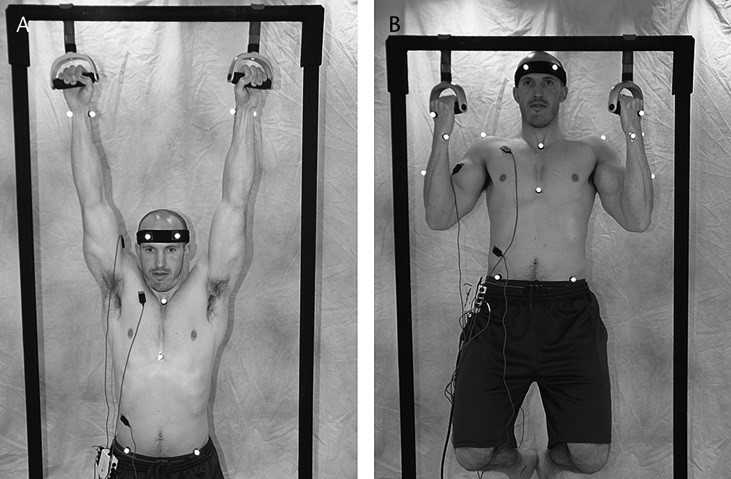This is one of the most commonly discussed doubts in weight training. What is better pullup/chin-up or lat pulldown? Let’s discuss…

A studycompared the kinematics and muscle activity between chin-ups (wide grip pullups, addressed as chin-ups in the study), and lat-pull down exercises and between muscle groups during the two exercises. Activation of biceps brachii, triceps brachii, pectoralis major, latissimus dorsi, rectus abdominus, and erector spinae and kinematics of back, shoulder, and seventh cervical vertebrae (C7) was analysed during chin-ups and lat-pull down exercises.
The researchers found that, activation of bicep and erector spinae and kinematics of shoulder and C7 for chin-ups were greater than lat-pull down exercises during the concentric phase. For the eccentric phase, activation of rectus abdominis during lat-pull down exercises was greater than pullups and the kinematics of C7 during pullups was greater than lat-pull down exercises.
Thus, pullups produced a greater level of muscle activity for the biceps and erector spinae than the lat-pull down exercise which may be due to chin-ups allowing greater degrees of freedom.
Researchers also found that, pullups is considered a more unstable movement, whereby the lower extremity is capable of moving free from resistance along the horizontal plane which displaces the body centre of gravity from the vertical alignment with the grasp on the bar.
In comparison, a lat-pull down exercise can be considered to be more stable as the lower extremity is motionless underneath the knee pads. Although the bar of the lat-pull down machine is not in a fixed position similar to that of a chin-up bar, the constant pull from the cable enhances the stability of the exercise condition by resisting upper extremity movements in the horizontal plane.
A studyinvestigated if the muscle activity in latissimus dorsi, biceps brachii, trapezius and rectus abdominis differed between a chin-up and a lat pulldown exercise, both at 100% bodyweight load. In this study 20 men participated and performed five chin-ups and lat pulldowns at 100 % of their bodyweight. Half of the subjects started with chin-ups and the other half with lat pulldowns.
The researchers saw that for the chin-up exercise, the biceps had a significantly lower average muscle activity and the rectus abdominis a significantly higher average muscle activity compared to the lat pulldown exercise.
For the two back muscles; trapezius and lats no differences for the average muscle activity between two exercises were found.
A studycompared a conventional pull-up and chin-up with a rotational exercise using Perfect·Pullup twisting handles. The researchers found the pronated grip during pull-ups to be most effective at activating the lower trapezius compared with the supinated grip.
The pronated grip also resulted in an increased muscle activity of the infraspinatus compared with the grip of the perfect pull-up which uses 2 handles with the ability to rotate 360deg (the subject starts with a pronated grip then the movement ends with the subject in a supinated grip).

(Perfect Pull-up: https://bit.ly/3E8wgv8)
In contrast, the perfect pull-up was found to show an increase of muscle activation of the latissimus dorsi compared with the supinated grip of the chin-up. The supinated grip did elicit an increase in pectoralis major muscle activity and bicep brachii compared with the pronated variation.
A studyinvestigated whether muscle activation patterns are similar between the traditional body weight pull- up and various alternative pulling exercises often used to train for improved performance in the pull-up. Participants performed 5 repetitions of each of the 4 exercises; body weight pull-up, seated lat-pulldown at 80% BW, kneeling lat-pulldown at 80% BW, and assisted pull-up.
Of the four muscle groups assessed, the rectus abdominis was the most active muscle group for all participants when performing the pullup. High activation levels of the core musculature are not surprising as this muscle group helps to maintain a rigid body position throughout the pullup. The pullup is performed while being suspended from a bar, and therefore requires greater stabilization of the core throughout the execution of the exercise, than would be required if performed from a solid base of support (e.g. seated lat pulldown).

During the pullup, the muscle activation was seen in the decreasing order of rectus abdominis, biceps, lats & traps. The kneeling pull-up was the only alternative pulling exercise observed to have the same activation pattern. None of the alternative pulling exercises were observed to have the same magnitude of activation pattern as the pull-up.
In an extensive studyBret Contreras, measured the mean & peak activation of the biceps, lats, & traps, during various back and bicep exercises. Though we will be focussing on the pullups, chin-ups and pulldowns for our topic.
For the research, Bret used weight from which five reps could be performed, except for the weighted chin-ups and pullups, where 3RM rep range was used.
(Bret explains mean and peak activation as: “
.”)
| Exercise | Long Head of Biceps | Lats | Mid Trap | Lower Trap |
| Bodyweight Chin Up | 43.2 100.0 |
80.5 133.0 |
32.2 71.4 |
44.6 101.0 |
| Bodyweight Close Parallel Grip Pull Up | 40.3 90.4 |
82.5 131.0 |
24.2 58.0 |
31.6 69.1 |
| Bodyweight Wide Parallel Grip Pull Up | 38.2 90.2 |
75.6 140.0 |
24.3 62.6 |
32.5 83.8 |
| Bodyweight Wide Pronated Grip Pull Up | 28.0 65.8 |
85.5 151.0 |
27.9 63.3 |
33.4 87.3 |
| 90 lb Chin Up | 107.0 205.0 |
108.0 159.0 |
41.9 80.2 |
58.3 104.0 |
| 70 lb Wide Parallel Grip Pull Up | 109.0 184.0 |
75.3 145.0 |
41.2 79.1 |
50.9 105.0 |
| 45 lb Wide Pronated Grip Pull Up | 65.8 145.0 |
102.0 167.0 |
33.4 77.6 |
41.1 115.0 |
| 280 lb Underhand Grip Pulldown | 22.3 54.6 |
71.2 129.0 |
22.7 55.0 |
32.6 74.0 |
| 240 lb Wide Grip Pulldown | 16.2 52.9 |
63.5 108.0 |
29.0 56.6 |
38.8 69.5 |
| 240 lb Behind Neck Wide Grip Pulldown | 23.7 74.6 |
67.0 117.0 |
23.6 63.8 |
32.3 85.6 |
| 260 lb Narrow Parallel Grip Pulldown | 22.9 51.4 |
58.7 97.5 |
29.9 62.6 |
42.2 87.4 |
Based on the experiment, the top exercises in terms of mean and peak activation of each body part:
Biceps
Mean: Weighted Wide Parallel-Grip Pull-up, Weighted Chin-up
Peak: Weighted Chin-up, Weighted Wide Parallel-Grip Pull-up
Lats
Mean: Weighted Chin-up, Weighted Pronated Wide-Grip Pull-up
Peak: Weighted Pronated Wide-Grip Pull-up



